In his six years at HashiCorp, Kevin Fishner has strung together a unique set of startup experiences. He joined the cloud infrastructure automation company in 2014 as the first business hire, going on to spin up the sales, solutions engineering, account management, and marketing teams. Afterwards, he spent a few years building out the product management and education groups as VP of Product. But for the last year and a half, he’s had a different perch — as the Chief of Staff.
We’ve written about the Chief of Staff role before here on The Review, of course. This increasingly commonplace startup role typically involves making the CEO more effective, prioritizing precious time, optimizing workflows and perhaps driving strategic projects. But Fishner’s mandate has a slightly different focus.
“My responsibility is to treat the company like a product, where employees are the user. Like a product manager, I spend my days thinking about what we should build and improve on, owning the components that make the company's culture and productivity come to life,” says Fishner. “We do that by asking this question: What are the core systems that are the manifestation of the culture that we want to build? At HashiCorp, we’ve grown from a few hundred to over a thousand people, so the goal is to build scalable systems that enable employees to do their best work and contribute to the outcomes of the company. For us, that’s shaped up into three specific systems: strategic planning, knowledge management, and communications.”
In this exclusive interview, Fishner unpacks what that entails, putting HashiCorp’s operations under a microscope and open sourcing his best practices and templates. We found it to be a fascinating conversation, and we hope you agree. For starters, Fishner’s got the rare ability to flip between the philosophical and the practical — one minute he’s talking about how determinism influenced his thinking on company building, and then a few minutes later he’s walking us through the exact template HashiCorp uses in its highly-structured annual planning process.
But more broadly, we’ve found that the mechanics and tactical ins-and-outs of how companies operate are still underexplored topics in the startup world. Most company systems evolve organically, either hastily cobbled together as the speed of scale takes over, or neglected until they’re forlorn and rather inflexible. Here, Fishner makes a thoughtful case for why the systems side of company building should get more attention, digging into the nitty-gritty details of two specific systems — how the HashiCorp team sets and tracks progress toward goals, and makes decisions through writing.
Whether you’re eyeing a chief of staff role, or you’re a founder hoping to set the right foundation for your fledgling company, read on for a unique chance to dive seriously deep into how one company functions — and garner inspiration for your own startup systems.
WHY YOUR FIRST 10 SYSTEMS ARE CRUCIAL
So much startup advice comes down to one common element: Hiring the best people. Whether it’s Twitter threads about how the first 50 hires set the cultural tone, or blog posts recommending that a founder interview the first 100 employees, most pointers are about keeping an unwavering focus on the people who power startups.
“While I definitely agree that people are your most important asset, I’ve noticed that most content doesn't talk as much about the systems. What I don't come across as often is a read about how the systems that those first hires build are the manifestation of the culture,” says Fishner.
In his view, it’s not an either or — it’s both. “While early employees are of course a driving factor for the company culture, they’re only half the equation. The other half is the foundational systems,” he says. “The comparison I like to draw is the nature versus nurture debate. Both your genes and your memes are highly influential on your outcomes. Likewise, both your people and your systems are highly influential on your company's outcomes — but the system side doesn't get as much attention as it should.”
Care about your first 10 systems as much as you care about your first 10 hires.
Fishner expands on why he thinks systems deserve equal footing. “While early employees help set implicit norms, building systems early in a company's lifecycle sets explicit norms. How do decisions get made? How are meetings structured? How are goals set? These systems are much easier to build when the company is small, and very challenging to put into place as the company grows,” he says.

This point is particularly resonant these days. “The shift to remote work shows us how tricky this can be. Most of the interpersonal interactions you have day-to-day are through Slack, email, Google Docs, and Zoom meetings. So it's very possible that for many employees, their only face-to-face human interaction for the day is through a meeting. If that meeting is good, then their day is good. If that meeting is bad, then their day is bad,” he says. In response, many companies are trying to encourage more writing and fewer meetings, but find it challenging to adopt this practice because it's not an existing explicit norm, Fishner says. “For an established company, implementing new systems takes top-down executive authority.”
Founders: The earlier you can understand what practices are important to you, the better. Turn those practices into systems as soon as you can.
Fishner’s conviction here surprisingly comes from his college days. “I studied philosophy. My thesis was on the impacts of subconscious advertising techniques. Theories of economics are built on the foundational belief that individuals are rational, well-informed and autonomous. But in practice, none of those things are true. For example, we’re far from autonomous — each person influences other people,” he says.
“In my reading and research for the thesis, I came to more of a determinist worldview that free will is overrated and our willpower is overstated. We're actually much more influenced by the environments that we're put in. These points are really well-made in ‘Atomic Habits.’ If you want to eat better or exercise, don't rely on your willpower. Instead, change some of your environmental influences that lead to those behaviors, such as having sugar in your house.”
Here’s where the connection to startups comes in. “The same is true in company building — instead of relying completely on the willpower and independence of all your employees, think about how to build better systems and create the environment where people can do their best work,” says Fishner.
He extends the philosophy parallel even further. “Elon Musk has a quote that gets repeated all the time, essentially saying that a company is nothing more than a collection of individuals working towards a common mission. And I think that misses the mark. It’s like the Ship of Theseus thought experiment,” says Fishner.
“Imagine you have a big wooden pirate ship and over 100 years, you replace each piece of wood. At the end of that process, is it still the same ship? There's no clear answer, but it’s instructive to think of a company similarly. Employees could come and go over the course of 30 years to the point where none of the same employees are there. Is it the same company?” he asks. “I would argue yes.”
A company is a collection of both its people and its systems. People can come and go over the years, but the systems they put in place and gradually refine over time become part of the company — and companies ultimately compete based on if those systems are strong or not.
In the sections that follow, Fishner walks us through two of his company’s systems and how the team continually sharpens them. Fair warning — systems aren’t easy to copy and paste. “Everything I'm going to discuss is very important for HashiCorp, but I wouldn't say they're generalizable principles. So hopefully you can take them and remix them with your own ideas, — they’re not an absolute truth.”
SYSTEM #1: OPERATING CADENCE — WHY SOURCES OF TRUTH AND RITUALS ARE KEY TO STRATEGIC PLANNING
What HashiCorp vernacular dubs “operating cadence,” other startups would likely call goal-setting or OKRs, says Fishner. “The operating cadence is the quiet drum beat setting our direction and the rhythm driving the business. At HashiCorp, our operating cadence has three speeds — annual, quarterly, and weekly,” he says. Each speed is built on two components:
- Sources of truth: defines success in a clear, ideally quantifiable way.
- Rituals: a consistent practice to review that source of truth and build accountability.
Before we dive into each element, check out this quick overview below of the example sources of truth and rituals HashiCorp relies on to make progress and stay accountable at the annual, quarterly and weekly levels:
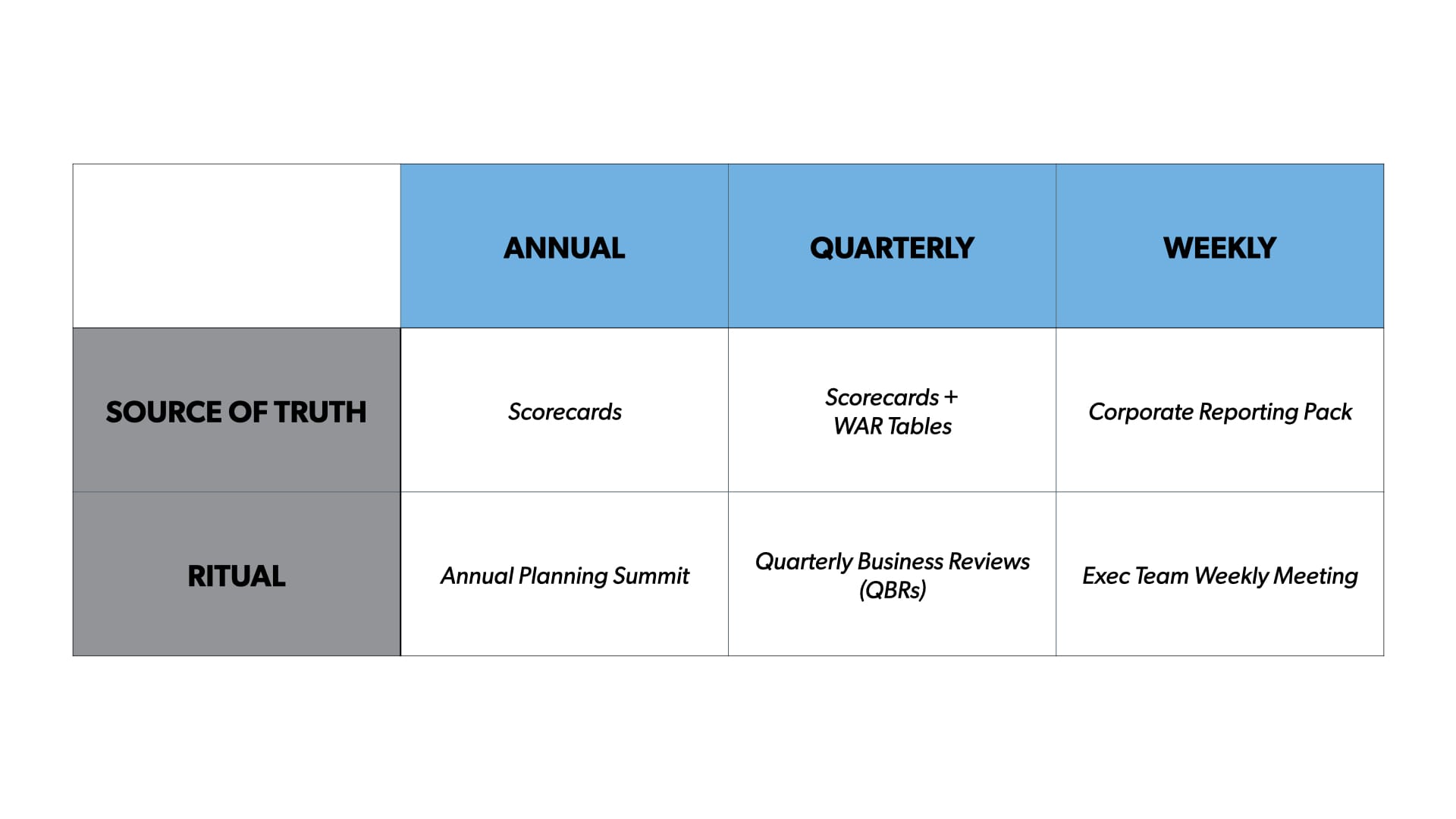
“If you get it right, this system can set clear expectations, track performance, and identify improvements to make along the way,” says Fishner. Unfortunately, for too many startups, this process tends to go sideways. You’ve likely encountered this pattern before: A rapidly-growing startup team encounters confusion about priorities, a lack of alignment, and wasted efforts, so someone suggests the company implement a goal-setting framework. After a lengthy process of setting OKRs, the wheels slowly start to come off. “Oftentimes companies will focus on the source of truth and not the ritual — and that's one of the biggest mistakes that you can make,” says Fishner.
“After OKRs are set, there's no ritual for reviewing them, so they quickly get out of date. Then employees start resenting them because the effort to actually create the goals was a waste of time — and OKRs slowly die because no one looks at them anymore. Expectations aren’t enough. It’s the ritual that it keeps the priorities top of mind and folks focused on what's important.”
OKRs only work if there is a ritual of reviewing progress and holding owners accountable for hitting their goals.
Annual planning:
Source of truth: Company scorecard, organized around 3 executive focuses and broken down in 12 sub-scorecards. See HashiCorp's template here or get our Google Doc version here.
Ritual: Annual planning summit
Timeframe: Brainstorming in September, resource allocation in October, then individual executive planning ahead of coming together for annual planning summit December.
“The first step for us is actually more long-term than an annual planning process. We started by defining high-level company success metrics as our North Star goals. Look for big, ambitious goals that come from years of execution. They’re usually lagging indicators that are almost useless to track quarterly. For us, these are fixed goals that frame our annual operating plans, but they change in magnitude each year,” he says.
“At HashiCorp, our first long-term goal is to win the practitioner (measured as a monthly active user account). Second is to enable the customer (measured through ARR). Third is to grow the ecosystem (measured as a percentage of revenue attributed to our partners). Our finance team then took those North Star goals and built a long-range plan, which is a five-year financial model with derivative financial metrics.”
With that context in place, let’s turn to the annual scorecard. “Essentially, it’s our incarnation of OKRs. Using our scorecard template, we define objectives and a set of key results for each objective, tracking progress on a quarterly basis. These objectives are at the highest level of the company, setting the overall priorities for the upcoming year,” says Fishner. “They’re the leverage points that we as an executive team think will have the most positive impact on reaching that five-year long range plan.”
Source of truth: Scorecards
Here’s how the scorecard gets filled in: “There’s an executive offsite in September where we do a structured brainstorming around what the top three executive focuses should be for our company objectives,” says Fishner.
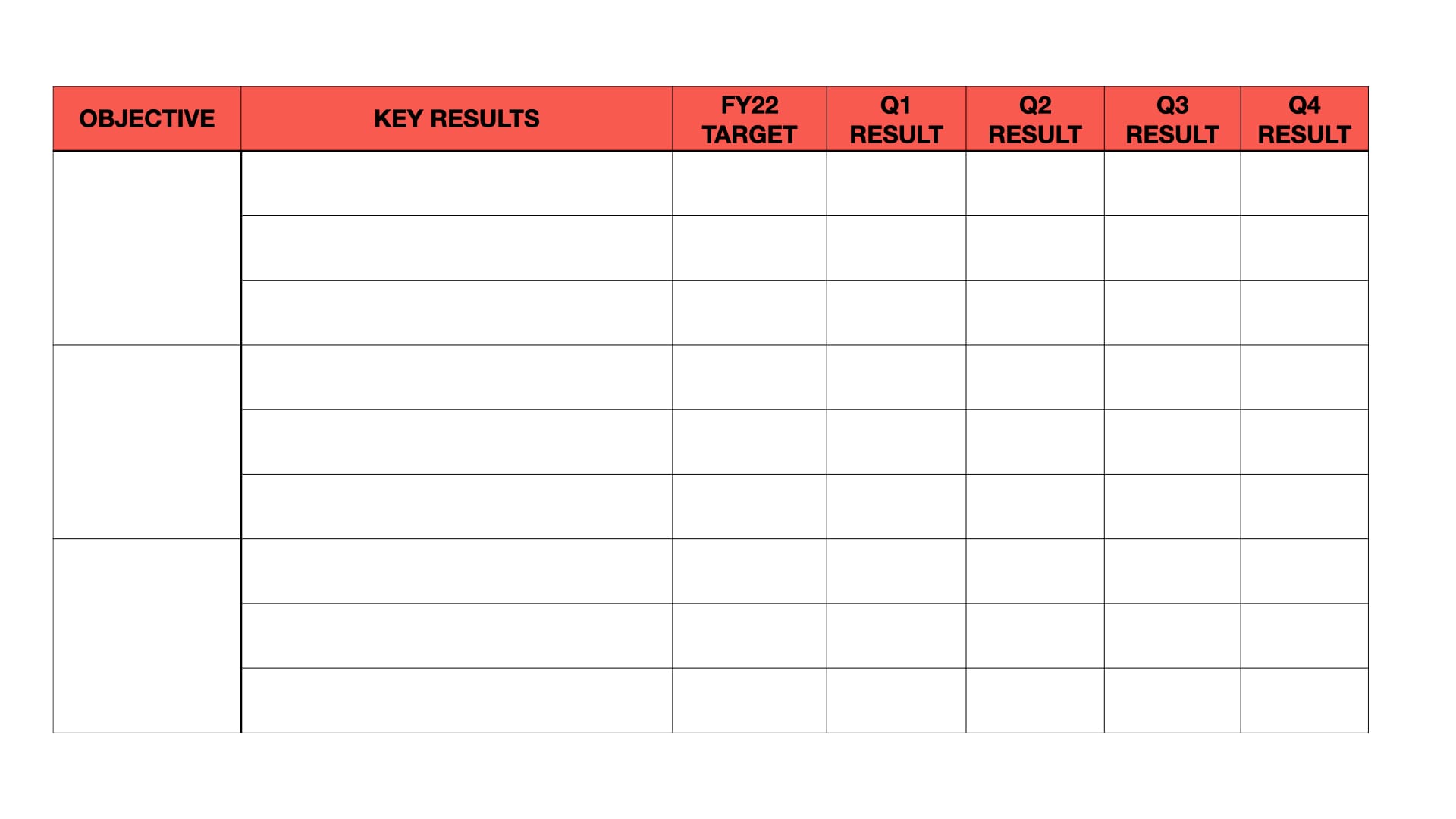
But it’s not a run-of-the-mill brainstorm. “There's a few Harvard Business Review studies around brainstorming that show when you just bring people together and ask them to put stickies up on a wall, it doesn't work that well. So we give executives two weeks before the offsite to write down what they think the three focuses should be for the upcoming year,” he says. “Then, each exec gets five minutes at the meeting to talk through their suggestions. Then we put all the suggestions into a list — there's usually quite a bit of overlap so we end up with about 15. Each exec then ranks five initiatives, five being the most important, one being the least, and then we just do a sorted ranking from there.”
This process has a few benefits, Fishner says. “First, allowing everyone to think about the objectives independently means they won’t get stuck in group think. Second, folks can often be more thoughtful when there's not as much urgency to come up with ideas on the spot. And finally, each leader gets equal airtime and opportunity to have their voice heard.”
With those high-level executive focuses as a starting point, the team dives a layer deeper. “We break down our company objectives (level 100) into goals by four ‘plans’ (level 200) — a go-to-market plan, product plan, people plan, and finance plan. Then, the go-to-market plan is broken down by field geography (Americas, EMEA, APJ) and the product plan is broken down by product line,” says Fishner. All told, they end up with 12 different scorecards.
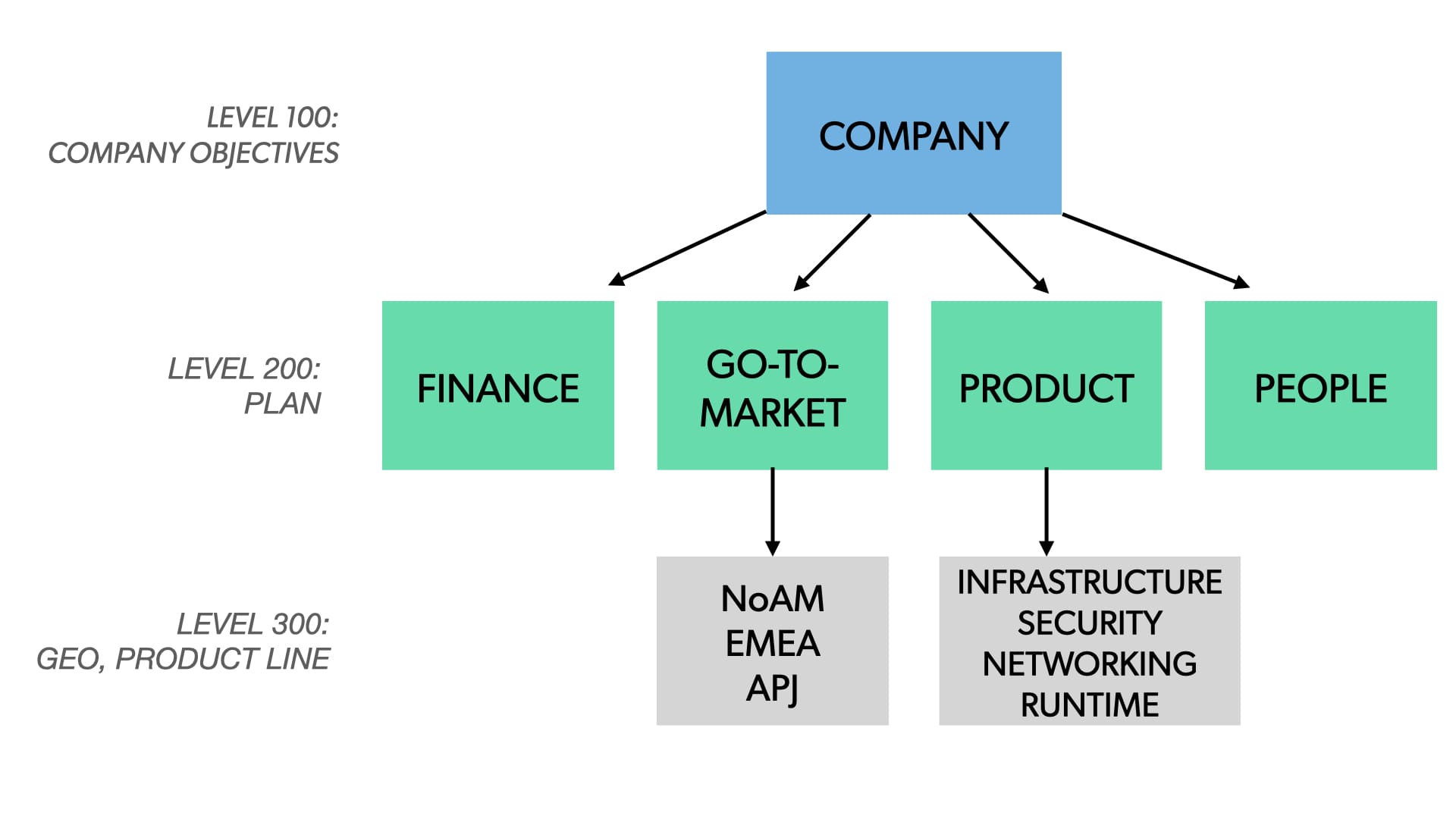
Interestingly, the “Level 200” plans are jointly owned. “Sales, marketing and customer success executives collaborate on our go-to-market scorecard, and product and eng executives work on our product scorecard. You don't often see that joint ownership in other goal frameworks, the thinking being that you want to have one directly responsible individual,” says Fishner. “But software isn’t something that can be broken down into very tiny constituent parts. It's not an assembly line.”
But that’s not an excuse to skimp on the details — hence the further breakdown by geography and product line. “It’s critical to properly segment company goals to surface insights. If goals are too high-level, over-performance in one product line hides the under-performance in another — which is well captured by Simpson's Paradox,” he says.
When you only look at high-level aggregate metrics, the nuance of what's really happening in your business gets lost.
But if goals are too low-level, the signal can get lost in the noise. “Importantly, we don't force our scorecards further down than the field geographies and the product lines. Take the Americas scorecard as an example,” says Fishner. “There’s about 150 sales, customer success, engineering, and field marketing folks dedicated to the Americas. Their scorecard focuses on metrics like top-line revenue, renewal rate, expansion rate, and then leading indicators like pipeline generation and coverage. As a leadership team, we don't try to cascade it down into individual regions like New York or Texas — that’s their responsibility.”
Ritual: Time to practice
“These draft executive scorecards get built from usually mid-October to December, which is when the annual planning summit is. We bring 70 senior leaders in the company together — this past year was remote of course, but we usually do it in person. It's two days, about four to five hours per day,” says Fishner.
What’s most unique is that the summit is focused on a business simulation. “Using a firm called BTS, we run a business simulation where leaders get to ‘run’ the business for three years. Taking a simplified view of the company, we essentially build a game board based on our five-year financial model and this year’s three executive focus areas,” says Fishner.
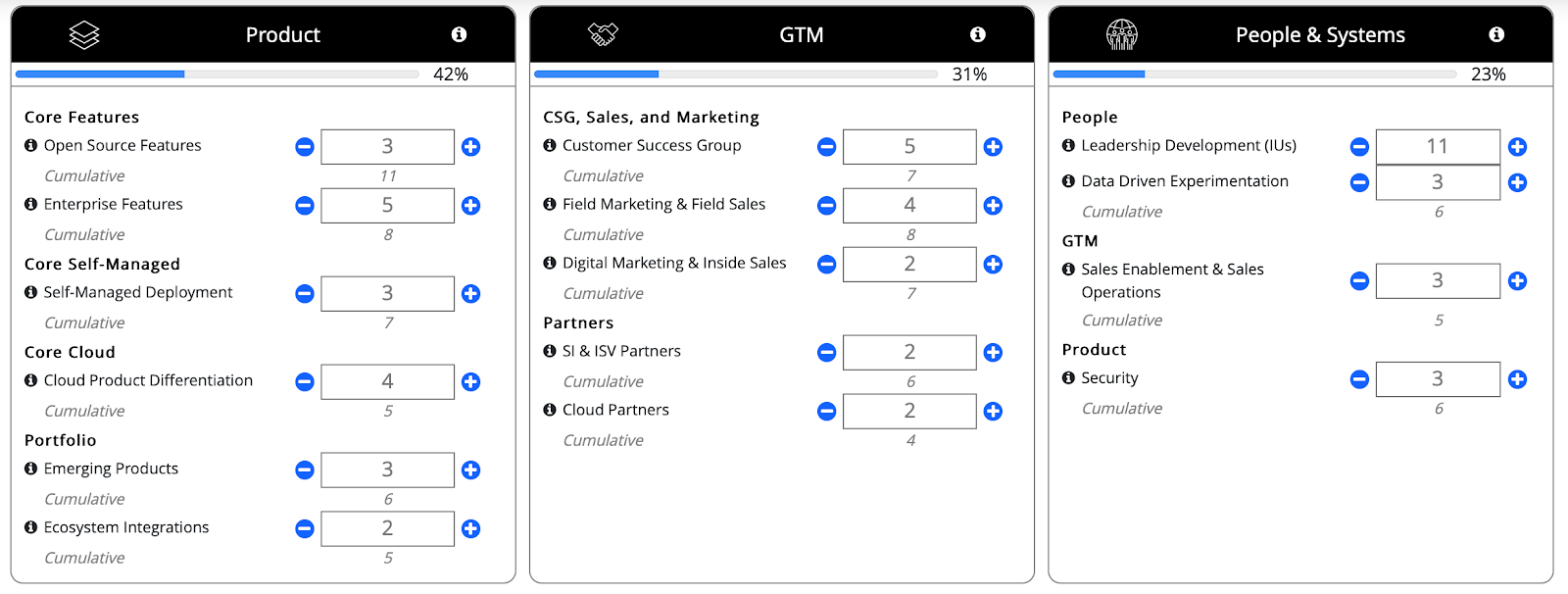
Here’s how it works: “We break folks up into teams of six, and they get to be the ‘CEO’ or the executive team for two days. Each round, your team gets to determine what initiatives to invest in. But there are ‘wobblers’ in the game, which are events that come up to throw you off track so you have to make a decision about how to adjust. It deepens our leaders’ understanding of not only what the priorities are for the year, but how they might play out in ‘practice.’”
Of course, this is a complex undertaking suited for bigger teams, so it may not work for your startup. “The essence of this exercise is the notion of practice. I grew up playing competitive soccer. We practiced four or five times a week and had games on the weekend — basically spending 90% of the time practicing and 10% of the time actually having to perform,” he says. “But when you get into a work environment, that notion of practice gets lost. So the simulation is about creating room for practice and making mistakes.” (Editor’s note: This excellent point from Fishner reminded us of Tyler Cowan’s question: What is it you do to train that is comparable to a pianist practicing scales?)
To bring that spirit to your company in a more simplified version, Fishner suggests more lightweight options. “Bring a smaller group of leaders together for an offsite. Create an exercise where you're sitting in someone else's shoes and going through one of their day-to-day activities, such as answering support tickets,” he says.
A setting for practice, making mistakes, and building up empathy for what other people are going through is key to any annual ritual.
Quarterly progress:
Source of truth: Scorecard and WAR tables.
Ritual: Quarterly business review (QBR)
Timeframe: 12 30-minute QBRs dedicated to reviewing each scorecard The audience is the executive team (all CEO direct reports) and extended leadership team (all VPs ), about 30 people.
With the annual plan fixed, the HashiCorp team turns their attention to their quarterly cadence. “Every quarter we review progress on all 12 scorecards in QBRs. The scorecards from the annual process get updated, filling in the columns with the previous quarter’s results. As an additional source of truth, there are Wins, Action Items, and Requests for Support (WAR) tables,” says Fishner. “The leaders review progress on the scorecard itself, read the team’s reflections and then discuss areas that might need improvement.”
Here’s what the WAR tables cover: “The team filling out the updates reflects on these questions: What are the wins? What are the great accomplishments that we should celebrate and keep moving forward on? What are the challenges and the action items? As an example, for one of our product lines, the activation rate — monthly active users divided by the signups — was low in a recent quarter,” he says.
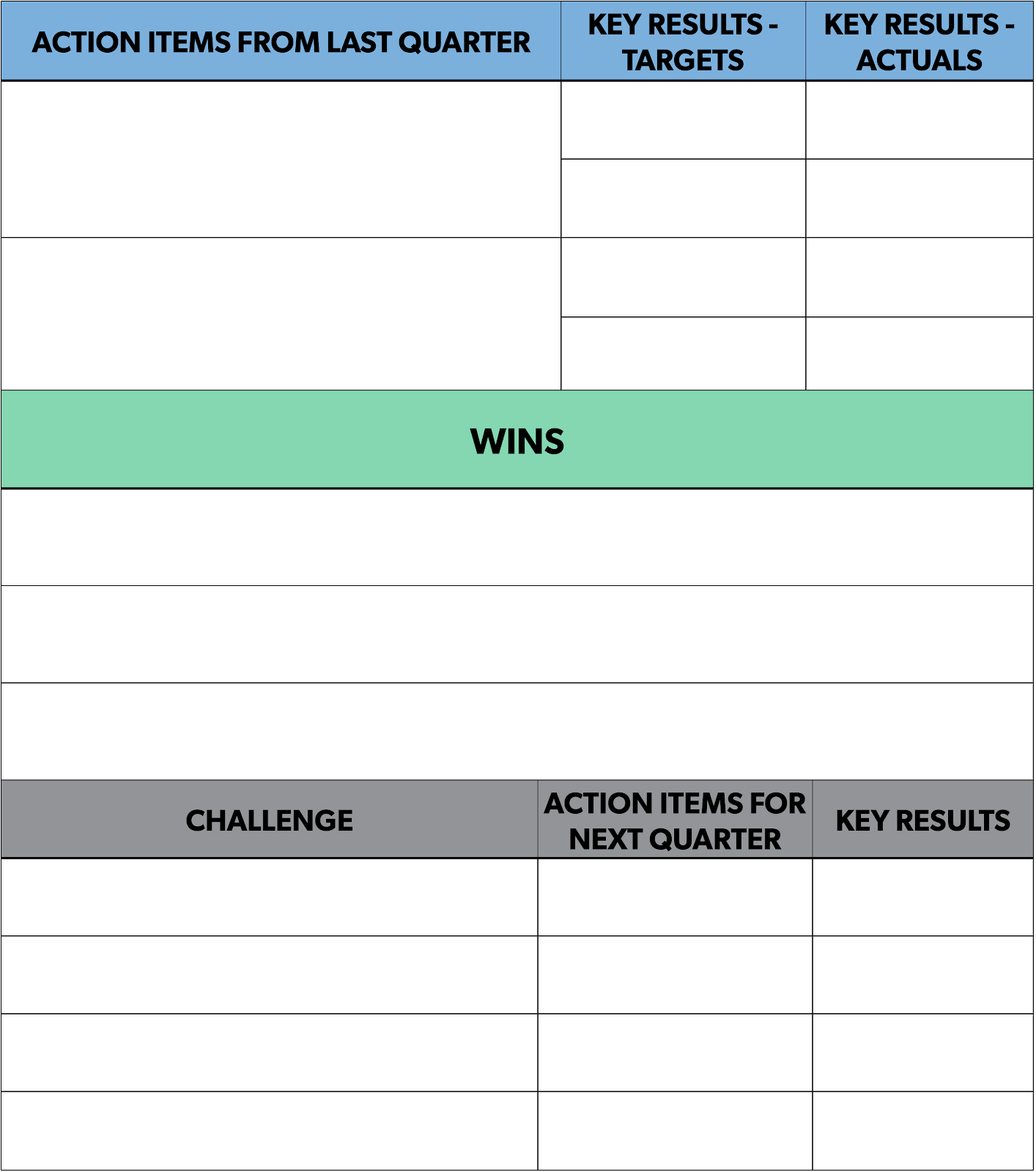
Here are two benefits Fishner sees from this approach:
- Reflection: “One of our principles is reflection not perfection. Goal setting is a process of reflecting on progress, not trying to get your goals so perfect upfront that you never need to change them. They're either off in terms of magnitude or completely misguided,” he says. “The QBRs create the space to reflect. Are we on track to hit goals? Are these the right goals? What can we do to improve?”
- Accountability: “As chief of staff, I don’t have the authority or the time to hold owners effectively accountable for their goals. The ritual is what creates accountability — the owners of the scorecards know that every quarter they will review their progress to the executive team and they will also review what they said they would accomplish last quarter,” he says.
The purpose of an operating cadence isn't to dogmatically stick to goals set at the beginning of the year. It's a ritual of reflection and introspection.
Weekly review:
Source of truth: Corporate reporting pack.
Ritual: Exec team meeting
Timeframe: One-hour meetings on Mondays, broken up into four 15-minute time slots
Now for the most granular level of HashiCorp’s operating cadence. “The corporate reporting pack is a superset of the metrics in the scorecards we review quarterly,” says Fishner. “It tracks everything from our current quarter sales forecast to our progress toward our hiring goals. It's an attempt to get as close as possible to a company cockpit where we can see leading and lagging indicators and know if the company is flying effectively.”
Fishner, along with a cross-functional group of sales operations, finance, and go-to-market folks, compiles this set of metrics every week. “The cross-functional element is important here. Take a question like ‘What is our sales forecast?’ Oftentimes the finance team and the sales team have different views on that,” he says. “After reviewing the metrics, we pull out insights — areas that are trending red that we need to take action on.”
Now for the weekly ritual. “It’s a more fine grain review of what's important for the company and how we're progressing. The exec team reviews the corporate reporting pack every Monday in a weekly hour-long meeting. For the first 15 minutes, we review the insights on the metrics. For the other three 15-minute slots, a guest speaker comes in to present on an action item that we identified in the previous QBR — another level of accountability to make sure that we’re following up on the challenges that we surfaced.”
Here’s the thinking behind this fine-tooth comb approach:
- Focus on leading indicators. A quarterly look just isn’t enough. “It's hard to change renewal performance in the current quarter. A renewal happens or doesn't happen based on the past year of customer experience with our products and services. We need to track leading indicators that create a strong renewal rate — customer onboarding, account health, and implementation services usage,” says Fishner. “For every lagging indicator, we need to have a set of leading indicators that we review on a weekly basis.”
- Focus on what matters. “The science of it is making sure your weekly reporting pack is truly representative of the most important metrics of the company,” says Fishner. “This level of weekly scrutiny keeps us on track to deliver our high-leverage actions — instead of getting distracted by the flow of urgent, low-leverage escalations. If a different leading indicator is acting up, there’s an impulse to take action on it. But if it’s not on the annual scorecard, then earlier in the year we agreed that we don't think that's very important for the health of the company — so it doesn't need to be something we focus on.”
Your rituals should keep you focused on what you decided was important earlier in the year — not on this week’s shiny distraction.
SYSTEM #2: HOW TO FORGE A COMPANY CULTURE OF WRITING AND DECISION DOCUMENTATION
“HashiCorp is a remote company with employees in 13 countries and 40 states. But I like to take one step back and describe us as an open source company,” says Fishner. “It’s a subtle difference, but an interesting one, especially with our company culture of writing. When you're working on open source software projects, there's a ton of written collaboration on GitHub. The origin of our writing practice comes from that open source ethos, as well as the philosophy and principles of the early employees,” he says.
“When Mitchell Hashimoto — the company’s co-founder and namesake — was in college, he would take a notebook with him everywhere. And whenever he had ideas for software projects, he was really diligent about writing them down first. So when he and his co-founder Armon Dadgar started working together, they would create thorough design documents and documentation before writing a single line of code,” says Fishner. “It was specifically on the engineering side at first, but something like 45 out of the first 50 employees were engineers, so that idea of writing the design before implementation became a core part of the company.”
For HashiCorp, their habit of writing is a way to document decisions and get buy-in before moving into implementation. Here’s how it works in practice. “We have two core documents. There’s a PRD, which in most companies is a product requirement document, but we've tweaked it a little bit to be a problem requirement document. It defines the problem. The second is the RFC, or request for comment. It proposes a solution or design, the implementation you want to get approval on before you start,” says Fishner.
We dive into each one below:
Defining the problem
See HashiCorp's PRD template here or grab our Google Doc version:
“Most large projects start with a PRD and are followed by an RFC, but not every RFC will have a PRD. The product management team definitely writes a lot of PRDs,” says Fishner. “But more generally, we’ve found that for some of the more ambiguous challenges we're facing — especially where there are many stakeholders — it's helpful to write a PRD first to make sure everybody's in agreement on the problem we’re actually solving.”
As for the document itself, these are the core sections:
- Background context. “In order for a reader to understand the content of the PRD, they must first understand the context.”
- Problem and personas. “This is the heart of the PRD as it simplifies the user research into clear problem statements. It also includes a list of personas and how they experience those problems statements.”
- Requirements and phases. “This is more of the traditional product management PRD that you would expect, with a list of requirements that the engineering RFC should satisfy. The problem is also broken down into phases to enable iterative implementation.”
The most important component? Your mindset while putting it together. “While the introduction section is read first, it should be authored last. Writing the overview last allows the author to summarize the final content of the PRD, rather than write an introduction without knowing the end result.”
Writing a PRD is about curating information, not creating it; you should go into the process without preconceived notions of what you’ll find.
Scoping the solution
See HashiCorp's RFC template here or grab our Google Doc version
“The guiding principle that we use for whether or not you should write an RFC or not is if the time it takes to make the change is faster than writing the document itself,” says Fishner.
“The RFC itself is really two core sections: the background, and then the proposal. The guiding goal of the background section is: as a newcomer to this project (new employee, team transfer), can I read the background section and follow any links to get the full context of why this change is necessary?” he says.
“In the proposal, there are a bunch of subsections for different aspects of the implementation, including impacts to UX and UI. The last piece is the constituents who approve and give feedback,” says Fishner. “But there's a third optional section called the abandoned ideas. We found that there were really good debates happening in the RFCs. Rather than only leaving what the outcome of those debates were, capturing those alternative ideas gives a more holistic picture and helps the reader understand what the writers were exploring.”
Fishner runs us through an example of an RFC in action outside of the engineering org. “The finance team writes lots of RFCs about what our expense system should be or how we should put together our long-range plan. The background section might explain the finance planning cycles. Then in the proposal itself, they might list considerations, such as arriving at our North Star metrics within 5 years, building a path towards EBITDA profitability, or setting the guard rails to not violate a magic number of one — the current year revenue divided by last year sales and marketing cost,” he says.
“From there they break down the exact components of the long-range plan: our income statement, cash flows, our non-GAAP ARR table, and so on. They then collect comments or feedback on that basic plan, and get it approved and implemented. Afterwards, you send your RFC to the company-wide email list. While most will just read the email rather than the full RFC, sending it to the list gives visibility into decisions being made across the company.”
Fishner shares more about the art of putting this document together. “Funnily enough, we do have a RFC for how to write RFCs, as well as an RFC template that everybody follows. We've learned a lot over the past six, seven years on these written documents, and there are good reasons for why the template is the way it is,” he says.
The process of getting feedback on RFCs is also critical. “First, it’s important to make sure that the solution is appropriate and takes in the necessary perspectives. But second, it's a cultural practice,” says Fishner. “Feedback on RFCs is one of the predominant ways we give feedback in the company. The first rule is to make sure that you're giving feedback on the document itself, not the person. That means changing the way you write the feedback. Instead of, ‘Why did you write this?’ say, ‘Why is this aspect of the solution the right way to go?’”
THREE PARTING PRINCIPLES FOR FELLOW CHIEFS OF STAFF
As a capstone, Fishner shares three lessons he’s learned from architecting these systems in his capacity as chief of staff. Draw on them as you size up your startup’s own potential systems.
Principle #1: Be an observer not doer.
“This was a good lesson learned when I just stepped into the chief of staff role. You get an interesting perspective on a company because you get the CEO's lens of how functions are operating and collaborating with each other. And it becomes really easy to spot problems, between sales and marketing, or sales and customer success. The pitfall is thinking that you can go and fix them. As the chief of staff, you could be responsible for proposing the solution — in our case, writing an RFC and building the source of truth — but you will never be responsible for the ritual. And the ritual is where change happens.”
He shares a specific example. “When I first stepped into the role 18 months ago, we had a discrepancy between the way that sales, marketing, and customer success were segmenting our users. They all had a slightly different model. I approached it with a ‘doer’ mindset. I thought if I just define a customer segmentation model, they'll all use it. And while we were able to get to a model that we all agreed on, because I wasn't in those seats, running those meetings and building the rituals, it was never adopted.”
As chief of staff, you can observe challenges, but you're not really the person to solve them.
Principle #2: Find and enact leverage.
“If there’s anything I've learned as a chief of staff, it’s that leverage is the most important thing you can find — by which I mean, finding the actions that you can take that have the most positive cascading impacts across the company,” says Fishner.
The purpose of leverage is to create as much change as possible with as little effort as possible. “An executive team has limited resources. Every quarter we need to ruthlessly prioritize our focus areas. As a chief of staff, you’re a supporting function to the executive team. It’s your job to make sure the executive team is aligned on the most impactful decisions that we can make as a group,” he says.
“When I first started working on the operating cadence, I kind of lost sight of that purpose. As I’ve done it more, I’ve seen that finding that leverage is about creating a system of observation where you can understand what's going on in different parts of the company. You can see where the soft spots are, and doggedly hold folks to fixing the spots that could have the most dramatic improvement on the company itself. And that's really what the operating cadence system is about. The system to define goals and track progress is a means to the end of finding high leverage actions.”
It’s not about OKRs or any other goal-setting acronyms. If the system doesn’t surface the highest leverage improvements to make, it’s not a productive system.
Principle #3: Sample inspiration, but make sure you remix it.
“I’ve done a good amount of research on other companies’ practices, and the ones that are most influential on us are Amazon and Microsoft. For example, the scorecards are definitely inspired by Microsoft. And while we didn’t copy Amazon’s practice of written memos exactly, it's good validation that it works and it can work at a very, very large scale,” says Fishner.
“But it’s important to remember that these systems are very much cultural artifacts. This has been really apparent to me as companies have been forced to adopt remote work over the past year. Whenever I’m asked for advice on remote practices, the one I lead with is always writing. I walk through a few of our RFCs and the process overall, and 99% of the time, the reaction is, ‘This is great, but it will never work at our company,” he says.
“And this is why it comes back to building systems. Early in the company life cycle, if you treat your core systems with just as much gravitas as your early employees, those systems will build the culture. That’s why the systems need to be organic to the company itself. You can take inspiration from other companies, but it's really just inspiration. You need to remix it with other ideas. Let go of the idea that you're creating new innovations, but rather see how you're creating unique combinations of existing ideas for that work for the specific setting of your company.”
This article is a lightly-edited summary of Kevin Fishner's appearance on our new podcast, "In Depth." If you haven't listened to our show yet, be sure to check it out here.
Cover image by Getty Images / Jorg Greuel. Templates courtesy of HashiCorp.
